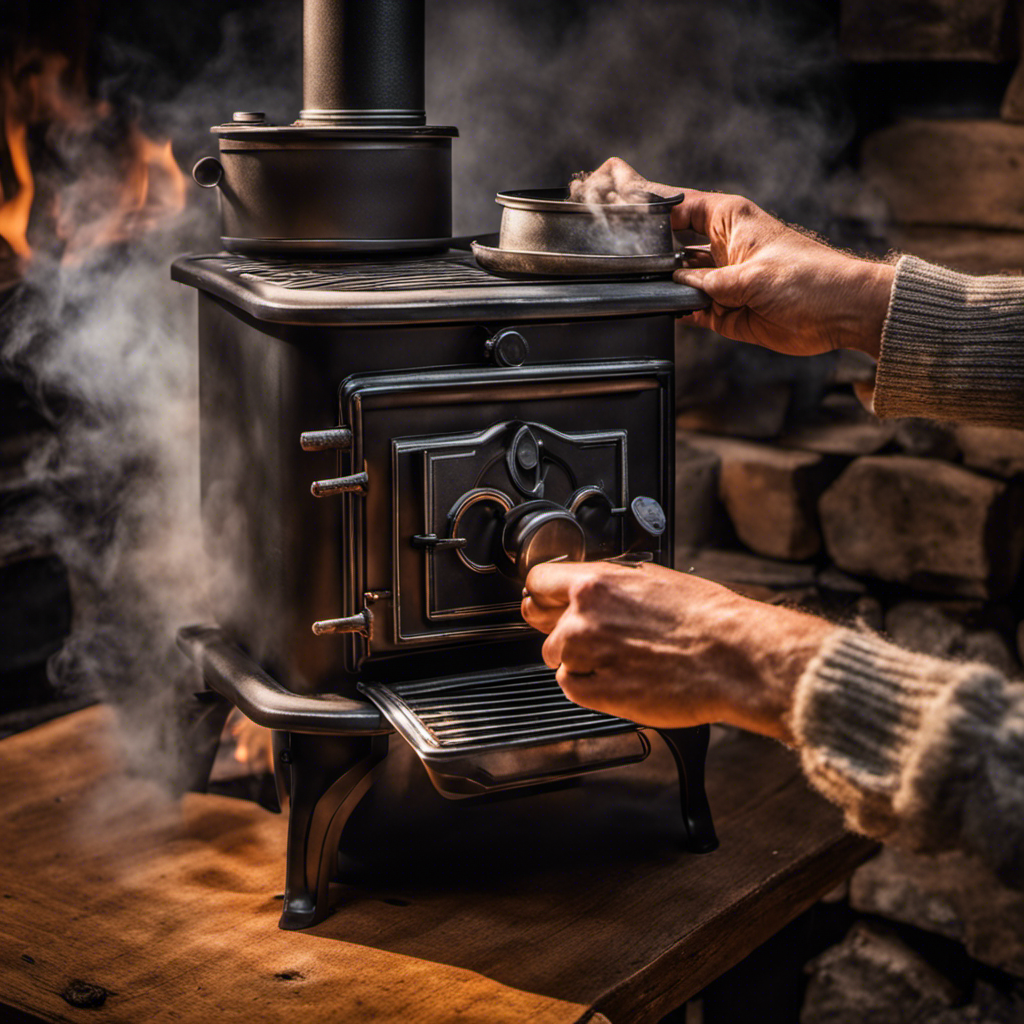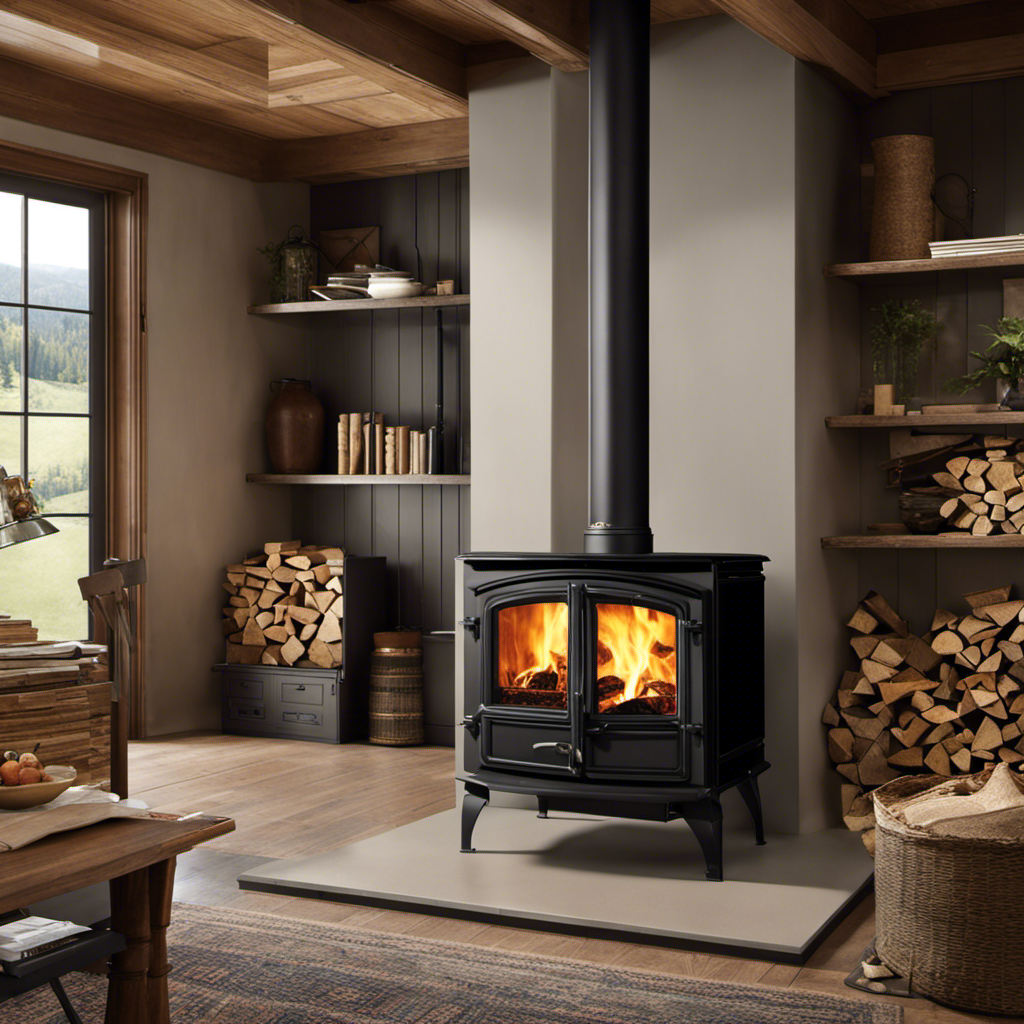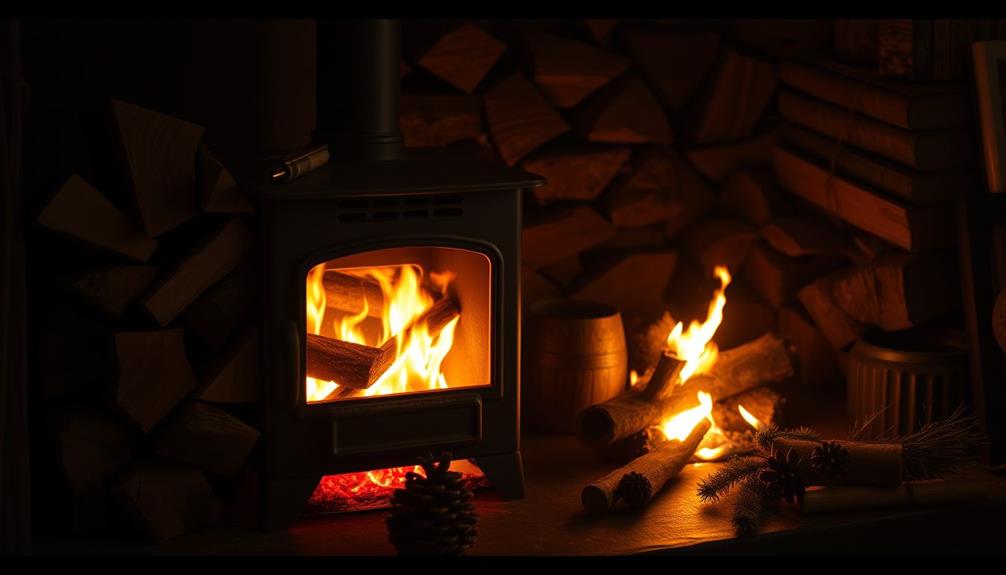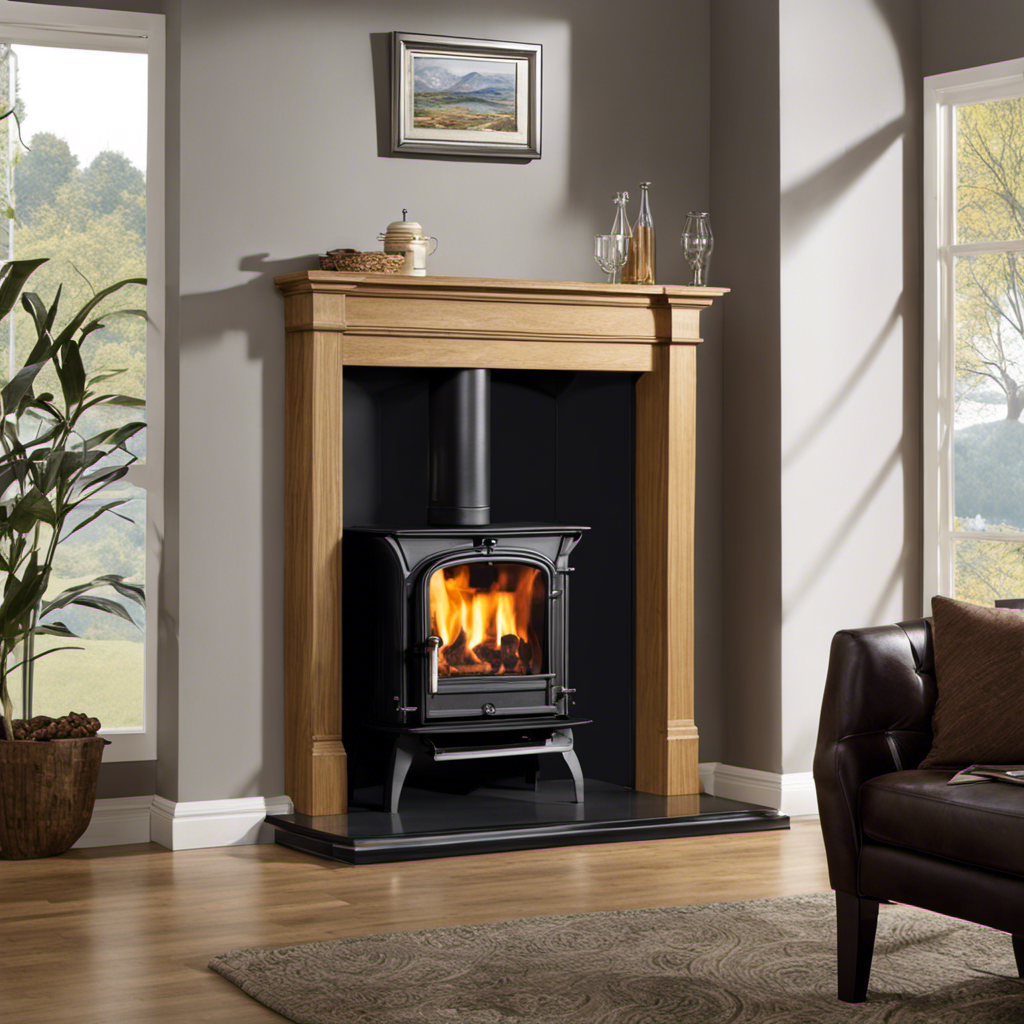I have always been intrigued by the idea of perfecting the art of controlling the flame in my wood stove. It may seem simple, but it has always proved to be a challenge for me. However, fear not, as I have now found the techniques to effectively manage the fire.
In this article, I will share with you the techniques and tips I’ve learned along the way. With a little understanding of airflow, adjusting the damper, and choosing the right wood, you’ll be able to achieve the perfect flame every time.
Key Takeaways
- Adjusting the damper controls the amount of air entering the stove
- Choosing the right wood for optimal burn improves flame control
- Managing heat output with firewood placement enhances wood stove performance
- Regular maintenance ensures consistent flame and prevents hazards
Understanding the Airflow Mechanism
I need to figure out how to properly adjust the damper to control the airflow mechanism inside the wood stove. Controlling the oxygen supply is crucial for achieving better flame control. By adjusting the damper, I can regulate the amount of air that enters the stove, which directly affects the intensity of the fire.
Opening the damper allows more oxygen to flow in, resulting in a more vigorous flame. On the other hand, closing the damper restricts the airflow and reduces the flame’s intensity.
Additionally, utilizing stove fans can greatly enhance airflow efficiency. These fans help distribute the heated air throughout the room by pushing it away from the stove, providing a more efficient and even heat distribution.
Mastering the damper adjustments and using stove fans effectively will ensure optimal flame control and efficient heating.
Adjusting the Damper for Ideal Flame
To achieve the ideal flame on a wood stove, adjusting the damper and monitoring the airflow are essential.
The damper control techniques play a crucial role in maintaining the desired heat output and ensuring efficient combustion. First, it’s important to understand the different types of dampers and their functions. The primary air damper controls the amount of oxygen entering the firebox, while the secondary air damper regulates the air supply for secondary combustion.
Troubleshooting common damper issues involves checking for obstructions or blockages in the damper mechanism, ensuring proper alignment and sealing, and cleaning any buildup of soot or creosote.
Adjusting the damper requires careful observation of the flame and making small adjustments to achieve the desired burn rate.
Choosing the Right Wood for Optimal Burn
Although it may seem insignificant, choosing the right wood is crucial for achieving an optimal burn in your wood stove. When it comes to controlling the flame, the type of wood you use plays a significant role.
Here are some key points to consider:
-
Seasoning firewood for efficient combustion: It’s essential to use properly seasoned firewood, as it contains less moisture. Seasoning firewood involves allowing it to dry for at least six months before use. This ensures that the wood burns more efficiently, producing a cleaner and longer-lasting flame.
-
Types of wood to avoid for a controlled flame: Some types of wood are better suited for burning in a wood stove than others. Avoid using green or wet wood, as they contain high moisture content, leading to smokier fires and decreased heat output. Softwoods like pine or spruce should also be avoided, as they tend to burn quickly and create less controllable flames.
By selecting well-seasoned hardwoods like oak, maple, or birch, you can achieve a more controlled and efficient burn in your wood stove.
Managing the Heat Output With Firewood Placement
One important aspect of managing the heat output in my wood stove is arranging the firewood in a strategic manner. Controlling heat distribution and maximizing fuel efficiency are key factors in ensuring that my wood stove operates at its best.
To achieve this, I start by placing larger logs at the bottom of the stove, creating a solid base. This allows for better airflow and helps maintain a steady temperature.
Next, I stack smaller logs on top, creating a pyramid shape. This arrangement promotes efficient combustion and even heat distribution.
Additionally, I ensure that the firewood is properly seasoned to prevent excessive smoke and improve overall burn efficiency.
Maintaining a Consistent Flame With Regular Maintenance
I find that regularly cleaning and inspecting my wood stove’s components, like the flue and chimney, is crucial for maintaining a consistent flame and preventing any potential hazards. Here are a few reasons why:
-
Importance of cleaning the stovepipe: Over time, creosote and other debris can build up in the stovepipe, obstructing airflow and increasing the risk of a chimney fire. Regular cleaning helps to remove these blockages and ensures proper ventilation.
-
Using a stove fan for better heat distribution: A stove fan can greatly improve the heat distribution in your home by circulating the warm air produced by the wood stove. This helps to eliminate cold spots and creates a more comfortable environment.
-
Checking the gaskets and seals: The gaskets and seals on your wood stove play a crucial role in preventing air leaks. By regularly inspecting and replacing damaged gaskets, you can ensure that your stove operates efficiently and reduces the risk of carbon monoxide poisoning.
-
Cleaning the ash and debris: Accumulated ash and debris can affect the performance of your wood stove. Regularly cleaning out the ashpan and removing any debris from the firebox helps to maintain proper airflow and allows for a consistent flame.
Frequently Asked Questions
How Often Should I Clean the Chimney of My Wood Stove?
I clean the chimney of my wood stove at least once a year to prevent creosote buildup. Regular cleaning ensures proper airflow and reduces the risk of chimney fires. Here’s how to clean a wood stove chimney.
Can I Use Softwood as Firewood in My Wood Stove?
Using softwood as firewood in a wood stove can have a negative impact on efficiency. Hardwood is better for wood stoves due to its higher density and longer burn time.
How Do I Prevent Excessive Smoke From Coming Out of My Wood Stove?
To prevent excessive smoke from my wood stove, I adjust the air intake. By finding the right balance, I can control the flame and ensure efficient combustion, reducing smoke and increasing heat output.
Is It Necessary to Have a Professional Inspect My Wood Stove Regularly?
It’s important to have a professional inspect your wood stove regularly. They can ensure it’s safe and operating efficiently. Plus, using a wood stove has benefits over other heating options and proper maintenance can extend its lifespan.
How Can I Control the Flame on My Wood Stove Without Adjusting the Damper?
To control the flame on a wood stove without adjusting the damper, I recommend using the air intake vents. By opening or closing them, you can regulate the amount of oxygen, controlling temperature and ensuring safety.
Conclusion
So there you have it, folks! By understanding the airflow mechanism and adjusting the damper, you can control the flame on your wood stove.
Choosing the right wood and managing firewood placement are also important factors in achieving a well-controlled fire.
Regular maintenance is key to ensuring the optimal performance of your wood stove.
With these tips and tricks, you can become a true fire-wrangling pro.
Imagine yourself as the master of flames, taming them with your expert knowledge and skill.
Get ready to bask in the warmth of a perfectly controlled fire, while your friends marvel at your fire-controlling prowess.
Happy wood stove adventures!
Logan’s affair with adventure began in childhood. He hailed from a small town where vast forests bordered one side and endless shores stretched on the other. His days were spent exploring uncharted woods, climbing tall trees, or listening to the tales of old sailors. This early immersion in a world brimming with stories and mysteries became the foundation of his passion for writing.











